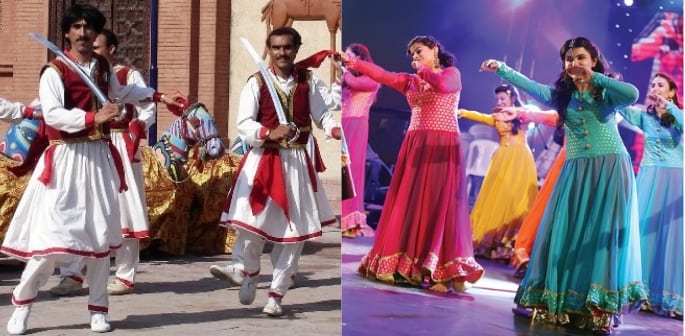Music and Dance
Introduction:

Pakistan, a land rich in cultural diversity and artistic heritage, boasts a vibrant tradition of music and dance that reflects the country's multifaceted identity. From the soul-stirring melodies of classical music to the exuberant rhythms of folk dances, Pakistani music and dance forms resonate with the echoes of history, tradition, and innovation. In this comprehensive exploration, we embark on a journey through the rich tapestry of Pakistan's musical and dance traditions, tracing their historical roots, cultural significance, and contemporary expressions.
Historical and Cultural Context:

The history of music and dance in Pakistan is deeply intertwined with the region's rich cultural tapestry and historical legacy. Ancient civilizations such as the Indus Valley Civilization and Gandhara laid the foundation for musical and artistic expressions, evident in archaeological findings such as musical instruments and dance sculptures. Islamic influences, particularly Sufism, played a significant role in shaping Pakistan's musical landscape, with the spread of devotional music and mystical dance forms across the region. The patronage of Mughal emperors further enriched the cultural milieu, fostering the development of classical music and dance traditions. Despite the partition of British India in 1947, Pakistan's musical and dance traditions continue to thrive, drawing inspiration from diverse sources, including Persian, Central Asian, and South Asian influences.
Classical Music:

a. Hindustani Classical Music:
Hindustani classical music, rooted in the ancient musical traditions of the Indian subcontinent, holds a prominent place in Pakistan's cultural heritage. It is characterized by its intricate melodic structures, improvisational techniques, and emotive expressions. Classical vocalists such as Ustad Nusrat Fateh Ali Khan, Ustad Ghulam Ali Khan, and Abida Parveen have achieved international acclaim for their mastery of classical ragas and ghazals, captivating audiences with their soulful renditions.
b. Classical Instruments:
Pakistani classical music encompasses a rich array of traditional instruments, each with its unique timbre, repertoire, and cultural significance. Instruments such as the sitar, tabla, sarangi, harmonium, and flute are commonly used in classical music performances.
Folk Music:

a. Qawwali:
Qawwali, a devotional music tradition originating from Sufi mysticism, holds a special place in Pakistan's musical heritage. Characterized by its repetitive rhythms, ecstatic melodies, and spiritual poetry, qawwali aims to evoke a sense of spiritual transcendence and unity. Renowned qawwals such as the Sabri Brothers, Nusrat Fateh Ali Khan, and Aziz Mian Qawwal have popularized the genre both within Pakistan and internationally, attracting audiences with their mesmerizing performances.
b. Regional Folk Music:
Pakistan's diverse regions are home to a myriad of folk music traditions, each reflecting the unique cultural heritage and linguistic diversity of its people. From the melodious tunes of Punjab's Heer Ranjha to the haunting melodies of Balochistan's Loris, folk music celebrates the richness and diversity of Pakistan's cultural landscape. Instruments such as the dhol, dholak, flute, sarangi, and tambourine are commonly used in folk music performances, adding depth, texture, and rhythm to the music.
Dance Forms:
a. Bhangra:
Bhangra, a lively folk dance originating from the Punjab region, is one of Pakistan's most popular and energetic dance forms. Characterized by its upbeat rhythms, vibrant costumes, and exuberant movements, bhangra celebrates the joy of life, community, and celebration. Dancers perform intricate footwork, energetic jumps, and rhythmic clapping to the accompaniment of traditional Punjabi music, including the dhol, tumbi, and dholak.
b. Kathak:
Kathak, a classical dance form with roots in North India, has a strong presence in Pakistan, particularly in the form of Kathak dance academies and performances. Known for its graceful movements, intricate footwork, and storytelling elements, Kathak embodies the elegance, sophistication, and cultural richness of Pakistan's classical heritage. Dancers such as Nahid Siddiqui and Sheema Kermani have garnered international acclaim for their mastery of Kathak, showcasing the timeless beauty and artistic excellence of this classical dance form.
c. Attan:
Attan, a traditional Pashtun dance performed in the Pashtun-majority regions of Pakistan, is characterized by its circular movements, synchronized footwork, and rhythmic clapping. It is often performed at weddings, festivals, and cultural events, serving as a symbol of Pashtun identity, pride, and unity.
Contemporary Expressions:

In addition to traditional music and dance forms, Pakistan's contemporary music and dance scene are vibrant and dynamic, with artists exploring new genres, styles, and expressions to connect with audiences both domestically and internationally. Pakistani pop music, rock, hip-hop, and electronic music have gained popularity, with artists such as Junoon, Atif Aslam, and Coke Studio Pakistan garnering widespread acclaim for their innovative soundscapes and cross-cultural collaborations.
Conclusion:
Music and dance are at the heart of Pakistan's cultural identity, serving as powerful expressions of emotion, tradition, and creativity. From the classical melodies of Hindustani ragas to the spirited rhythms of Punjabi bhangra, Pakistani music and dance forms embody the diversity, richness, and vitality of the nation's cultural heritage. As custodians of this rich legacy, Pakistani musicians, dancers, and artists continue to celebrate, innovate, and preserve their cultural traditions, ensuring that the melodies and movements of Pakistan endure for generations to come.